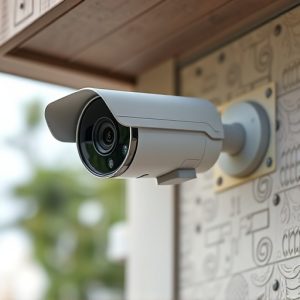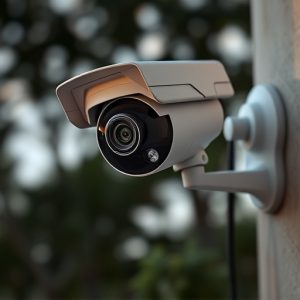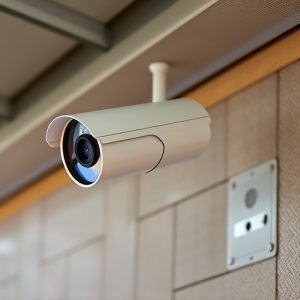Optimize Wireless Dummy Camera Placement: Expert Tips & Real-World Success
Infrared (IR) sensors, key for low-light surveillance, have led to the development of 'fake…….
Infrared (IR) sensors, key for low-light surveillance, have led to the development of 'fake' IR sensors used as placement aids for wireless dummy cameras. These fake sensors, designed to look realistic, help deter intruders by creating an illusion of robust security without drawing attention. Wireless dummy cameras offer cost-effective, energy-efficient security solutions that blend discreetly into environments like hallways and entryways, with the added benefit of remote monitoring via smart apps. Effective placement involves mimicking real camera positions, avoiding windows, and ensuring clear sightlines at eye level. Common mistakes include visible placements and improper infrared sensor calibration, which can lead to false alerts. By following Wireless Dummy Camera Placement Tips, homeowners and businesses can leverage these devices for enhanced security, complementing existing systems with comprehensive surveillance in low light conditions.
“Uncover the power of wireless dummy cameras with our comprehensive guide. Explore ‘Understanding Fake Camera Infrared Sensors’ to decipher their technology, followed by ‘Benefits’ that make them indispensable for security and surveillance. Learn optimal ‘Wireless Dummy Camera Placement Tips’ to maximize effectiveness without common pitfalls. Discover real-world applications and success stories, showcasing the versatility of these devices. Enhance your security setup with this essential read on wireless dummy camera placement.”
- Understanding Fake Camera Infrared Sensors
- Benefits of Using Wireless Dummy Cameras
- Strategies for Optimal Dummy Camera Placement
- Common Mistakes to Avoid When Setting Up Wireless Dummy Cameras
- Real-World Use Cases and Success Stories
Understanding Fake Camera Infrared Sensors
Infrared (IR) sensors are integral components in many security and surveillance systems, enabling cameras to capture low-light or night-time footage. However, the concept of ‘fake’ camera infrared sensors is a unique twist in the security industry. These dummy IR sensors are not designed to capture actual images but rather serve as placement tools for wireless dummy cameras. By strategically positioning these fake sensors, homeowners and business owners can create the illusion of a fully functional surveillance system, deterring potential intruders.
Wireless dummy camera placement tips suggest utilizing these fakes in areas where real cameras might be expected, such as corners or high-traffic zones. Their realistic design mimics the appearance of genuine IR sensors, making them an effective deterrent. Unlike traditional security systems, fake camera infrared sensors provide a subtle yet powerful way to enhance home or business security without drawing unnecessary attention.
Benefits of Using Wireless Dummy Cameras
Using wireless dummy cameras offers several advantages for both homeowners and businesses. One of the key benefits is their versatility in terms of placement. Unlike traditional security cameras, these dummy cameras can be easily installed and positioned discreetly around your property without the need for complex wiring or power outlets. This flexibility allows you to strategically place them in hard-to-reach areas or where real cameras might be visible as a deterrent.
Another advantage is cost-effectiveness. Wireless dummy cameras are an affordable alternative to high-end security systems, making them accessible to a broader range of users. They also consume less power, reducing energy costs. Moreover, these cameras can integrate seamlessly with existing home automation systems, enabling remote monitoring and enhancing overall security through smart device apps. Following Wireless Dummy Camera Placement Tips will ensure optimal benefits and peace of mind.
Strategies for Optimal Dummy Camera Placement
When strategically placing a wireless dummy camera, consider its environment and intended purpose. Position it in areas where regular cameras might be, like hallways, entryways, or rooms with valuable items—it should blend seamlessly to deter potential intruders. Avoid placing it too close to windows or where it’s easily visible from the outside, as this can alert someone to its dummy nature.
For optimal results, ensure the dummy camera has a clear line of sight without obstructions. This allows for the best visual coverage and prevents shadows that could distort the image. Additionally, keep it at eye level to mimic real surveillance, making it more effective in deterring crime or prying eyes.
Common Mistakes to Avoid When Setting Up Wireless Dummy Cameras
When setting up wireless dummy cameras, there are several common mistakes that homeowners often make. One of the most frequent errors is improper placement. Dummy cameras should be strategically positioned to mimic the look of a real security system, but many end up in plain sight or too close to windows and doors, negating their deterrence effect. Always consider the landscape and choose locations that offer natural cover, such as trees or shrubs, to make them less noticeable.
Another blunder is failing to test the infrared sensors accurately. These cameras rely on infrared LED lights for night vision, so it’s crucial to ensure they are aligned correctly and emit enough light to detect motion effectively. Many users forget to calibrate their sensors, leading to false alerts or missed detections. Regular testing and adjustments are key to achieving optimal performance, ensuring your Wireless Dummy Camera Placement Tips are as secure and reliable as possible.
Real-World Use Cases and Success Stories
In today’s digital age, where security is paramount, wireless dummy camera placement has become an effective and often overlooked solution for deterring crime. These infrared sensor LED dummy cameras offer a subtle yet powerful way to safeguard properties, providing peace of mind for homeowners and businesses alike. Their real-world use cases are diverse and impressive.
Success stories abound in various industries, from residential neighborhoods to commercial complexes. In some instances, dummy cameras have been strategically placed to prevent burglaries, with their infrared capabilities allowing them to capture clear images even in low-light conditions. Property managers have also utilized these wireless devices to monitor high-traffic areas, ensuring the safety of tenants and visitors. The versatility of these cameras is further highlighted by their ability to integrate seamlessly into existing security systems, providing a comprehensive surveillance solution.
Fake camera infrared sensors offer a cost-effective solution for enhancing security and deterring crime, with wireless dummy cameras providing added flexibility. By strategically placing these devices using tips like ensuring clear sight lines, positioning them near entry points, and hiding them discreetly, you can create an effective surveillance network without breaking the bank. Avoiding common setup mistakes, such as poor battery management and incorrect orientation, will ensure optimal performance. Real-world success stories highlight the impact of these cameras in various settings, demonstrating their value for both residential and commercial security.


